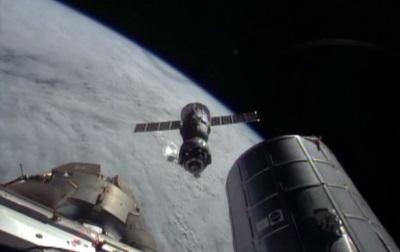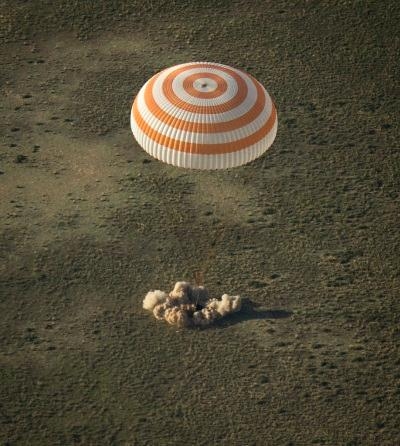Expedition 39 Members Spent 188 Days In Space
Three crew members from the International Space Station (ISS) returned to Earth Tuesday after 188 days in space, during which they orbited Earth more than 3,000 times and traveled almost 79.8 million miles.

Expedition 39 Commander Koichi Wakata of the Japan Aerospace Exploration Agency, Flight Engineer Rick Mastracchio of NASA and Soyuz commander Mikhail Tyurin of the Russian Federal Space Agency (Roscosmos) touched down southeast of the remote town of Dzhezkazgan in Kazakhstan Tuesday at 2158 EDT.
During Expedition 39, the crew participated in a variety of research, including a human immune system activation and suppression study and a protein crystal growth research study looking for proteins responsible for Huntington's disease and other neurodegenerative conditions. The crew also installed a new plant growth chamber designed to expand in-orbit food production capabilities.
One of several key research focus areas during Expedition 39 was human health management for long duration space travel, as NASA and Roscosmos prepare for two crew members to spend one year aboard the space station in 2015.
During their time aboard the orbiting laboratory, the trio welcomed three cargo spacecraft. A Russian ISS Progress cargo vehicle docked to the station, bringing tons of supplies, and another Progress craft conducted tests on an upgraded automated rendezvous system. In January, Orbital Sciences' Cygnus spacecraft arrived at the station as part of Orbital's first commercial resupply mission. In April, SpaceX launched its Dragon spacecraft to the station for the SpaceX-3 cargo resupply mission. Both capsules were loaded with cargo and science experiments. This was Orbital's first of at least eight cargo flights to the space station, and it was the third of at least 12 flights for SpaceX scheduled through 2016 under NASA's Commercial Resupply Services contract.
Mastracchio, Tyurin and Wakata arrived at the station Nov. 7 bearing the torch used to light the Olympic flame at Fisht Stadium in Sochi, Russia, which marked the start of the 2014 Winter Games in February.
During his time on the orbiting complex, Mastracchio ventured outside the confines of the space station for three contingency spacewalks. The first two were to remove and replace a faulty cooling pump, and the third to remove and replace a failed backup computer relay box.

The space station is more than a scientific research platform. It also serves as a test bed to demonstrate new technology. With the arrival of SpaceX-3, the Expedition 39 crew unloaded new climbing legs for NASA's Robonaut 2 (R2) humanoid robot. Designed to take over routine, dirty and potentially dangerous tasks from astronauts, R2 will take its first steps toward mobility after the legs are attached and tested in the coming months. Further upgrades and a battery backpack, necessary for the robot to operate completely untethered, will launch to the station later this year. Ground controllers using the station's robotic arm also installed a new high-definition Earth-viewing camera system, referred to as HDEV, on the outside of the Columbus lab. HDEV is comprised of four commercially available HD cameras and streams online live video of Earth to online viewers around the world.
Having completed his fourth space station mission, Mastracchio now has spent 228 days in space. Wakata has spent 348 days in space on four flights and served as the first Japanese commander of the International Space Station. Tyurin has accumulated 532 days in space on three flights, making him 13th on the all-time endurance list.
Expedition 40 now is operating aboard the station, with Steve Swanson of NASA in command of the orbiting laboratory. Swanson and his crewmates, Flight Engineers Oleg Artemyev and Alexander Skvortsov of Roscosmos, will tend to the station as a three-person crew until the arrival in two weeks of three new crewmates: Reid Wiseman of NASA, Maxim Suraev of Roscosmos and Alexander Gerst of the European Space Agency. Wiseman, Suraev and Gerst are scheduled to launch from Kazakhstan May 28.
(Images provided by NASA)
 ANN's Daily Aero-Term (04.26.24): DETRESFA (Distress Phrase)
ANN's Daily Aero-Term (04.26.24): DETRESFA (Distress Phrase) ANN's Daily Aero-Linx (04.26.24)
ANN's Daily Aero-Linx (04.26.24) Airborne 04.22.24: Rotor X Worsens, Airport Fees 4 FNB?, USMC Drone Pilot
Airborne 04.22.24: Rotor X Worsens, Airport Fees 4 FNB?, USMC Drone Pilot Airborne 04.24.24: INTEGRAL E, Elixir USA, M700 RVSM
Airborne 04.24.24: INTEGRAL E, Elixir USA, M700 RVSM Airborne-NextGen 04.23.24: UAVOS UVH 170, magni650 Engine, World eVTOL Directory
Airborne-NextGen 04.23.24: UAVOS UVH 170, magni650 Engine, World eVTOL Directory




